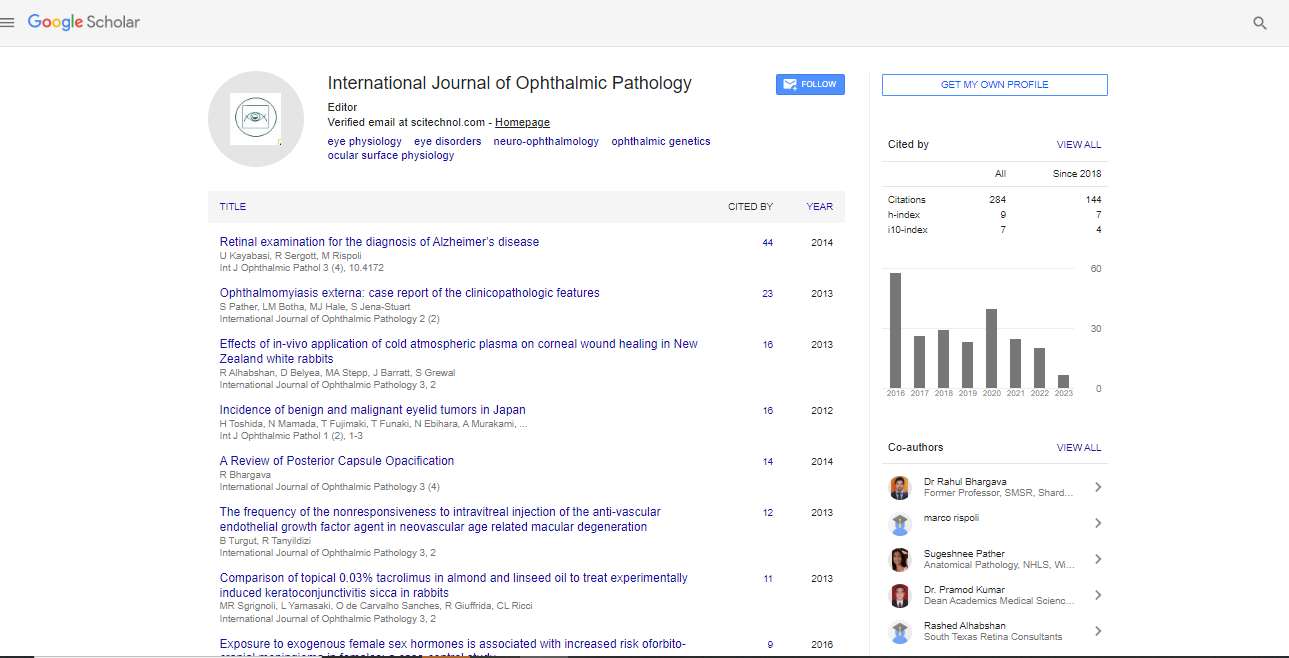Role of oxidative stress-induced peroxidative damage of cellular protein and lipid components in the development of Diabetic Retinopathy
Lakshmi Kanta Mondal, Subhasish Pramanik, Chiranjit Bose, Aditi Saha, Koena Bhattacharjee, Sayantan Ghosh
Institute of Ophthalmology Medical College, India
IPGME&R and SSKM Hospital, India
St. Xavier’s College, India
: Int J Ophthalmic Pathol
Abstract
Background: Diabetic retinopathy (DR) is one of the most emerging micro vascular complications leading to blindness among adults in their working-age group. The prevalence of DR is 21.7 %(Gadkari et al., 2016) among the subjects with T2DM in India. Several studies have indicated that hyperglycemia induced oxidative stress is a pathogenic force of DR. However, very few studies have demonstrated the vitreous markers of hyperglycemia mediated peroxidative degradation of membrane proteins and lipid in the pathways of development of DR. Purpose: Purpose of the study is to evaluate the surrogate markers of oxidative stress, peroxidation of proteins and lipids in serum and vitreous fluid of diabetic subjects with and without DR. Method: A group of 153 T2DM subjects comprising 91 with mild nonproliferative DR (NPDR) and 62 subjects without any DR (DNR) were recruited in the cross sectional study. Blood sample was collected from each subject. Vitreous fluid from 10 DNR subjects and 16 NPDR subjects was collected during vitrectomy. Erythrocytes’ Reactive oxygen species (ROS), serum and vitreous nicotinamide adenine dinucleotide phosphate oxidase (NADPH oxidase), protein carbonyl compound (PCC), lipid peroxide compound 4-Hydroxynonenal (4-HNE) and Hexanoyl lysine (HLY) were measured following standard methods. Results: This age, gender matched cross sectional study showed significantly higher level of RBC ROS and NADPH oxidase activity, PCC, 4-HNE and HLY in serum and vitreous level of NPDR subjects compared to DNR individuals. Further NADPH oxidase activity showed significant positive correlations with ROS, which demonstrated significant positive correlations with PCC, 4-HNE and HLY among study subjects. Conclusion: In diabetes mellitus NADPH oxidase derived ROS generation damages cellular protein and lipid components that invite apoptosis and dysfunction of retinal endothelial cells and trigger development of DR. Key Words: Diabetic Retinopathy, oxidative Stress, vitreous, protein carbonylation, lipid peroxidation.
Biography
Lakshmi KantaMondal has completed his MS at the age of 34 years from Regional Institute of Ophthalmology, Kolkata and PhD at the age of 56 years from West Bengal University of Health Sciences. He is a Professor of Regional Institute of Ophthalmology, Kolkata, a Medical College and Health Care Institute. He has published more than 20 papers in reputed journals.
 Spanish
Spanish  Chinese
Chinese  Russian
Russian  German
German  French
French  Japanese
Japanese  Portuguese
Portuguese  Hindi
Hindi 